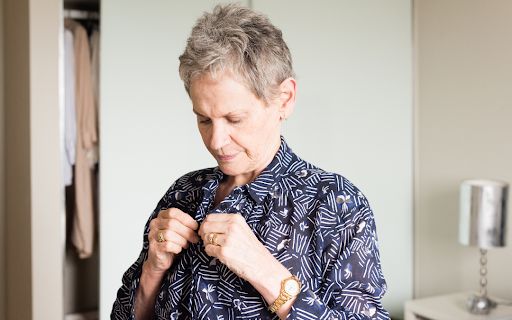One of the main difficulties that older adults and their caregivers face is something many of us don’t give a second thought—getting dressed. An estimated 30 percent of seniors require assistance with dressing. This figure increases to 38 percent if the individual has dementia, according to recent data. The dependence on a caregiver to help with such a basic, utilitarian activity as putting on clothes is often a source of frustration for older adults with limited mobility. Dressing others can also be arduous for family members who might lack the composure or self-confidence to help effectively.
To address this challenge, many retailers sell adaptive clothes that are functional, easy to put on, and comfortable. Adaptive clothes are made with unique considerations in mind, from slip-resistant shoes to zipper closure garments to wheelchair-accessible pants. Having this option can restore dignity and a certain level of autonomy to an older adult, while also reducing stress for the caregiver.
Read on to understand the specific benefits that adaptive clothes can offer, plus where to find them.
Adaptive Clothes Make Dressing More Convenient and Less Time-Consuming
Getting dressed shouldn’t be a hassle, but when there are small buttons, hooks, and snaps to contend with, this activity goes from a routine task to a lengthy ordeal. Shirts that have velcro in the front, jeans that zip down each leg, and sneakers that slide on instead of lace take this process from tedious and labor-intensive to quick and efficient. In addition, if a caregiver needs to monitor a healing medical procedure site or tend to incontinence, for example, adaptive clothes offer easy access without complete removal.
Adaptive Clothes Can Minimize Pain to Maximize Safety and Range of Motion
Sometimes the material and construction of traditional garments can be restrictive, painful or uncomfortable for those who already struggle to move their bodies. Many kinds of fabric will chafe against the skin, and rigid seams can increase pressure on brittle joints or bones.
Alternatively, adaptive clothes are usually seamless and made with softer, more elastic and less fibrous textiles. This ensures comfort and allows for ease of motion. Adaptive clothing also helps decrease the risk of injuries because this freedom to move unencumbered means a lower chance of falling or straining the body.
Adaptive Clothes Enable Seniors to Feel Independent
With the loss of motor skills that comes as a person ages, difficulty with a “simple” function such as getting dressed becomes just one more reminder that the individual is not as agile as they used to be. For some, this is moderately irritating, but for others, it can be utterly demoralizing as they wrestle with a lack of control and self-reliance over their own daily habits. There’s a basic human pride in caring for oneself, so when older adults regain the ability to clasp their shirts or zip their pants with minimal assistance, this independence will enhance their quality of life.
Brands and Retailers That Sell Affordable, High-Quality Adaptive Clothes
About one in five Americans have some kind of limited mobility, which requires adaptive clothing, points out CBS News. In fact, the report continues, this demographic is the third-largest consumer base in the United States alone, and the global demand for adaptive clothes is projected to reach $393 billion by 2026.
As this adaptive clothes market seeks to fulfill the needs of a historically underserved population, more and more retailers are jumping on the trend. Here are some online brands that offer adaptive clothes in functional, modern styles for a reasonable price.
- Zappos Adaptive
- Tommy Adaptive
- Buck & Buck
- Silvert’s
- Alium Adaptive
- Reboundwear
- Nike FlyEase
- IZ Adaptive
Making Life Easier with Adaptive Clothing
Adaptive clothes are no longer just clunky velcro sneakers or baggy tracksuits. Instead, brands now make adaptive clothes for all occasions, ages, and body types.

